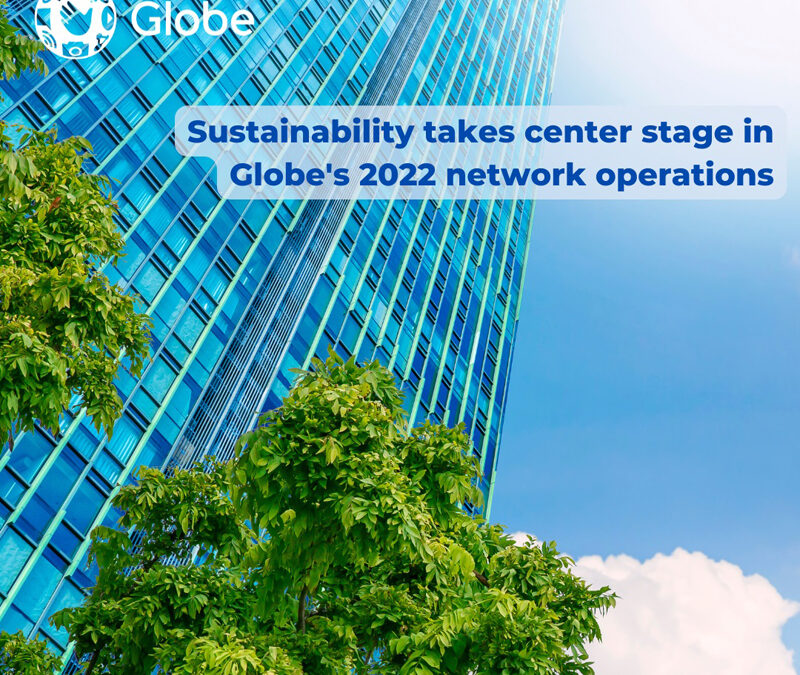The year 2022 was a banner year for Globe’s efforts to integrate sustainability into its network operations, as the digital solutions platform continued to roll out green technologies towards achieving Net Zero Greenhouse Gas Emissions (GHG) by 2050.
“Our goal at Globe is to continue to operationalize climate action within our network operations. We are proud to be taking tangible steps towards a greener and more sustainable future for all,” said Yoly Crisanto, Globe Group Chief Sustainability and Corporate Communications Officer.
Last year, the company secured the ISO 50001:2018 certification of its Energy Management System (EnMS) covering key facilities including corporate offices, core network, cell sites, data centers, and stores. This management system establishes the company’s framework for energy efficiency, resource conservation, and network optimization as part of its climate action strategy for the business.
Focusing on responsible energy sourcing, Globe shifted 10 facilities in Cavite, Cebu, Quezon City, Manila, Marikina, and Laguna to clean energy last year in partnership with the Ayala Group’s renewable energy platform ACEN.
This brings to 24 the total number of high-energy utilization facilities now running on renewable energy, including its headquarters The Globe Tower in BGC, Taguig, six in Quezon City, five in Cavite, three in Cebu, two in Makati City, and one each in Mandaluyong, San Juan, Manila, Marikina, Batangas, and Tarlac.
Globe encourages more investments towards clean energy by dealing with Retail Energy Suppliers (RES) to support the country’s commitment to reducing GHG emissions by 75 percent in 2030 through the Nationally Determined Contribution (NDC) of the Paris Agreement.
On reducing reliance on fossil fuels, it also piloted alternative energy sources, including solar-hybrid power plants or mini-grid and advanced solar Hybrid Generator Sets, for off-grid and bad-grid cell towers in Luzon.
Aside from financial savings from energy consumption, operations, and maintenance in cell sites, the use of renewable energy and hybrid power alternative sources increases site uptime and ensures the availability of continuous backup power during disasters. This year, Globe looks to progressively deploy the technology across its sites nationwide.
Globe is also building a green and low-carbon optical network with the help of Huawei Technologies. Last year, it deployed energy efficient technologies in its Access and Transport Networks to optimize its operations.
For its access network, the company utilized the Blade Optical Line Terminal (OLT) and Intelligent Optical Network Terminal (ONT). Blade OLT is deployed in various outdoor wireless sites that reduces energy consumption by 50% and utilizes natural heat dissipation. The Intelligent ONT, on the other hand, utilizes an Intelligent Application Performance Management (APM) that reduces energy consumption by 30% by optimizing device performance for active and idle modes.
For its transport network, the company deployed Access Dense Wavelength-Division Multiplexing (DWDM) and Optical Cross Connect (OCX). Access DWDM simplifies the traditional equipment rooms to outdoor cabinets, resulting in faster rollouts by reducing space and energy consumption by 60% and 40%, respectively. Similarly, the OXC simplifies multiple cabinets, subracks, and fibers into one equipment, saving 80% of space and 70% of energy consumption.
Lastly, Globe introduced sustainability as a metric for its network equipment and software vendors, which forms 10% of the overall evaluation criteria. Aside from being assessed in technical and financial metrics, vendors must also look at how their products can contribute to the company’s climate action strategy. Globe engages its business partners, vendors, and suppliers, to adopt and promote sustainable practices that the company implements.
All these initiatives contribute to the company’s commitment to Climate Action including its participation in the UN-backed Race to Zero global campaign, rallying non-state actors to halve global emissions by 2030 and deliver a healthier, fairer zero-carbon world by 2050.
In 2021, it became the first publicly-listed Philippine company to commit to the Science Based Target initiative (SBTi). It also committed to supporting the framework set by the globally-recognized Task Force on Climate-Related Financial Disclosures (TCFD) and vowed to abide by its recommendations for effective climate-related disclosures.
To learn more about Globe, visit https://www.globe.com.ph/.
Liked this post? Follow SwirlingOverCoffee on Facebook, YouTube, and Instagram.


